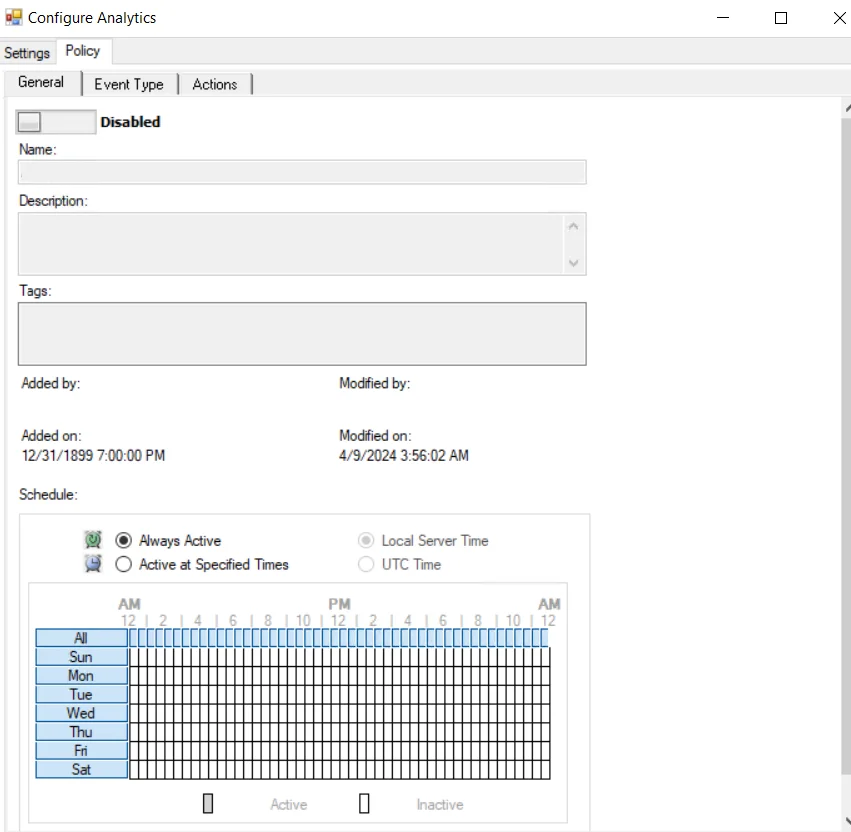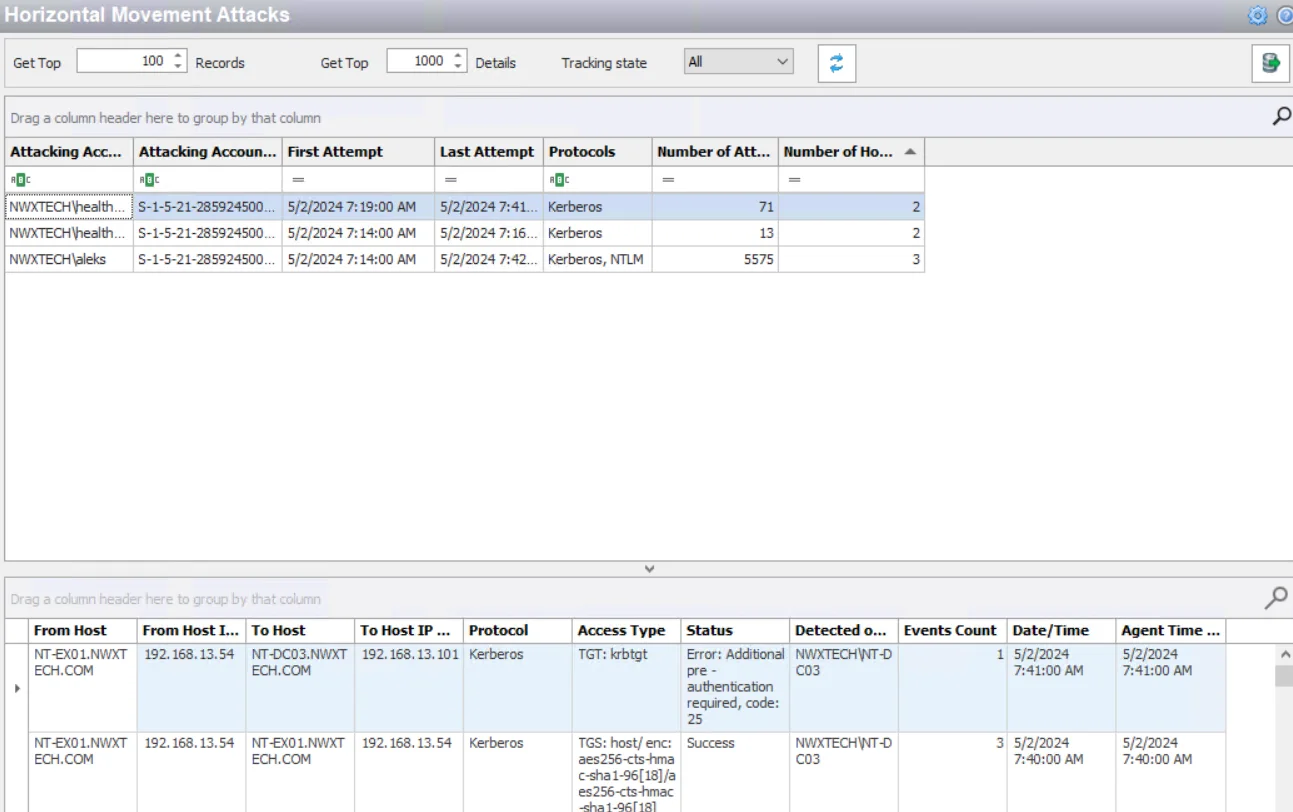Horizontal Movement Attacks Analytic Type
The Horizontal Movement Attacks analytic type identifies security principals that are accessing more than the threshold of resources during the specified time interval.
RECOMMENDED: Configure a subset of accounts and/or servers to be monitored in order to avoid the excessive volume of event activity from monitoring all.
| Horizontal Movement Attacks | |
|---|---|
| Definition | User account authentications across multiple network assets in a specified time period |
| Example | Malware uses several techniques to spread its payload during the initial phase of an attack including Pass the Hash, Impersonation, and current session logged on credentials. Regardless of the method, authentication takes place against other targets on the network, triggering a Threat Prevention horizontal movement alert. |
| Trigger | Successful or failed authentications of a given account across X number of resources in Y minutes |
| Recommended Settings | Configure this analytic to trigger a hit if Threat Prevention monitors successful or failed authentications of a given account across 10 resources in 3 minutes. |
Analytic Workflow
- Configure the analytic policy
- Enable the analytic policy
- Enable alerting on incidents through the System Alerting Window.
See the Horizontal Movement Attacks Analytic Data Grid topic for information on event data collected per incident.
Configure Horizontal Movement Attacks Analytic Policy
Open the Horizontal Movement Attacks Analytic Policy in any of the following ways:
- Click Analytics in the left pane to launch the Analytics interface. Then click the gear icon for the analytic.
- Expand the Analytics node and click the desired analytic. On the analytic window, click the gear icon available in the top right corner.
The Configure Analytics window has two tabs:
- Settings – Where the analytic trigger is defined
- Policy – Where filters can be added, additional actions configured, a custom schedule set, and the policy enabled
Settings Tab
Set the Number of Hosts and the Interval Duration to trigger the incident. The interval duration is set for (hours:minutes) and is capped at 23:59. When successful or failed authentications of a given account occurs across the specified number of hosts within the specified interval duration, it will trigger an incident record.
By default, authentication event data is cached in memory for 24 hours. When an incident is triggered, an incident record is saved to the database along with the events that triggered the incident. Raw authentication event data that did not contribute to an incident are purged from memory once they are more than 24 hours old.
If checked, the Ignore failed logins for unresolved user names option will exclude bad user IDs from contributing to Horizontal Movement Attacks incidents.
Policy Tab

The Policy tab for configuring analytics consists of three sub-tabs:
-
General tab – Configured the same way a regular policy’s General Tab is configured. The only exception is that the Name and Description are hard coded, and cannot be modified. The Tags field is disabled for analytics.
-
Event Type tab – Configured the same way a regular policy’s Event Type Tab is configured. The only exception is that the Authentication Monitoring Event Type is hard coded, and the Success filter cannot be modified.
-
Scope the accounts to include in or exclude from being monitored on the AD Perpetrator filter.
-
_Optional:_Scope the protocol to be monitored on the Authentication Protocol filter. If enabling the analytic on a domain controller, also scope the login type.
NOTE: The Exclude failed authentications with ‘N-2’ passwords option requires a GPO within the organization be configured to ‘Enforce password history’ with a setting of a minimum of ‘3 passwords remembered’ or it will not have an effect.
-
_Optional:_Scope the domains to be included in or excluded from monitoring on the Domains/Servers filter.
-
Optional: Scope the servers to be included in or excluded from monitoring on the IP Addresses (from) filter, the IP Addresses (to) filter, the Hosts (from) filter, or the Hosts (to) filter.
NOTE: Some authentication events may return only a host name (NetBIOS or FQDN), others may return only an IP address. It is recommended to take this into account when entering filter values.
-
-
Actions tab – Configured the same way a regular policy’s Actions Tab is configured. The only exceptions are that the “Send to Event DB” and “Email Notifications” options are disabled. The event data collected by analytic policies are stored in memory until an incident is triggered. For the “Send Raw Data to SIEM” option, use caution, as this will send all event data not the triggered incident, which could be a large volume of data. To send notifications on incidents, use the System Alerting Window to configure Email and SIEM alerts.
Horizontal Movement Attacks Analytic Data Grid
The data grid on the Horizontal Movement Attacks node lists one row per incident identified.

The data grid can be filtered according to the Event Tracker status: All, New, or Reviewed. See the Event Tracker Window topic for additional information.
The top data grid includes the following information for each incident:
-
Attacking Account Name – Security principal of the account that triggered the incident
NOTE: The name will be red if the attacking account is the Administrator account.
-
Attacking Account SID – Security Identifier of the account used in the event
-
First Attempt – Date timestamp of the first monitored event that triggered the incident. Hover over the data in this column to view the local time (of the Enterprise Manager) and UTC time simultaneously.
-
Last Attempt – Date timestamp of the last event that triggered the incident. Hover over the data in this column to view the local time (of the Enterprise Manager) and UTC time simultaneously.
-
Protocol – Protocol(s) used for the monitored operation
-
Number of Attempts – Number of attempts monitored during the specified interval matching this rule
-
Number of Hosts – Number of hosts accessed during the specified interval matching this rule
Select an incident in the top data grid to view information on the events that triggered the incident:
- From Host – Name of the originating host
- From Host IP Address – IP address of the originating host
- To Host – Name of the target host
- To Host IP Address – IP address of the target host
- Protocol – Protocol(s) used for the monitored operation
- Access Type – Type of authentication, e.g. RDP, CIFS, etc.
- Status – Detailed information on the error generated by the event
- Detected on DC – Fully-qualified name of the domain controller that detected the event
- Events Count – Number of identical events that occurred in one minute
- Date/Time – Date timestamp of the monitored event. Hover over the data in this column to view the local time (of the Enterprise Manager) and UTC time simultaneously.
- Agent Time Logged – Timestamp for when the Agent detected the event. This can be different from the Enterprise Manager time (displayed in the Date/Time column) due to latency.
This data grid employs features for sorting, filtering, searching, and more. See the Data Grid Functionality topic for additional information.